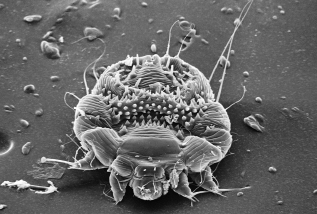| | Life cycle of Sarcoptes scabiei | How do cattle get mange? | Does this mite only affect cattle? | Can humans be infected? | How are cattle harmed? | How can mange be confirmed? | How are affected animals treated? | How can cattle be protected?
Sarcoptic mange, or barn itch, is a disease caused by the parasitic mite, Sarcoptes scabiei. Mange produced by this mite can be severe because the mite burrows deeply into the skin, causing intense itching. Cattle affected by sarcoptic mange lose grazing time and do not gain weight as rapidly as do uninfected cattle.
Life cycle of Sarcoptes scabiei
The entire life cycle of this microscopic mite (see Figure 1) occurs on the cow and takes 14 to 21 days to complete:
- The newly-mated female uses its teeth (called chelicerae) to form tunnels in which the life cycle is completed. During her life span, she will burrow up to 2 to 3 centimeters.
- A female lays 3 or 4 eggs each day, producing 40 to 50 eggs during her lifetime.
- Eggs hatch in four or five days, releasing larvae that will complete their development as either a male or female.
- Females remain in the existing tunnels or burrow side channels where they mate.
- Fertilized females continue producing new tunnels in which to deposit their eggs while the males die shortly after copulation.

Figure 1. Sarcoptes scabiei greatly magnified.
How do Cattle Get Mange?
Infection is usually spread by direct contact between cattle. Straw bedding and other objects that come into contact with infected animals can become contaminated with mites and can spread infection. Infestations are generally more common when cattle are housed for the winter and spread more slowly during summer months when cattle are on pasture.
Does this Mite Only Affect Cattle?
There are several varieties of Sarcoptes scabiei. Each variety generally occurs on a different host animal and is given a special name. For example, the cattle form is called Sarcoptes scabiei var. bovis, while the swine form is called Sarcoptes scabiei var. suis.
Sarcoptic mites are generally host-specific.
Can Humans be Infected?
An infection occurring on one host species does not readily transfer to another host species. However, mites from dogs and pigs can cause an irritating itch in humans that can persist for two or three weeks. Mites do not adapt well to humans; as such, only a few mites are present in human cases, and these mites do not form tunnels.
How are Cattle Harmed?
The feeding and burrowing activities of mites produce an intense irritation. Affected animals rub against posts, trees, and feeder bunks to relieve the irritation. This rubbing can result in localized or widespread hair loss.
When cattle rub to the point of bleeding, the injury to the skin produces a fluid called exudate. The exudate hardens and forms a crust, which produces the condition known as scab or scabies. When this situation occurs:
- scabs can appear on the inner surface of the thighs, the underside of the neck and brisket as well as around the root of the tail
- lesions can become widespread in advanced cases
- skin thickens and takes on an elephant skin appearance
The speed at which an infestation spreads over an animal depends on several factors:
- number of mites transmitted
- site of the infestation
- susceptibility of the host
Visible lesions on cattle heavily exposed to mites may appear in 10 to 14 days.
How Can Mange be Confirmed?
A diagnosis can be confirmed by finding mites during a microscopic examination of deep skin scrapings taken at the edge of a scaly area. The scraping should be made deep enough to cause bleeding of the skin.
The examination may need to be repeated before an infection can be confirmed for two reasons:
- some cattle become sensitized to the presence of only a few mites and may not appear to be infected
- the symptoms of scabies mimic those of some other dermatologic problems
How are Affected Animals Treated?
Several drugs are available to treat scabies. Contact a veterinarian to confirm the presence of Sarcoptes scabiei, and then get his/her advice on the most suitable treatment program.
How Can Cattle be Protected?
Several strategies are available that can be used to protect cattle from getting scabies:
- clean stalls used to house infected cattle, and add fresh bedding before reusing stalls for new animals
- disinfect grooming tools and other instruments used on infected animals
- isolate infected animals from the rest of the herd, and then treat them
- examine replacement cattle for mites before putting them with the rest of the herd avoid overcrowding
- ensure animals are well-nourished; cattle in poor condition are more susceptible to infection than healthy, well-fed animals
Prepared by:
Murray Kennedy, Ph.D.
Food Safety Division
Source: Agdex 663-47. March 2005. |
|